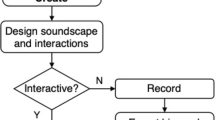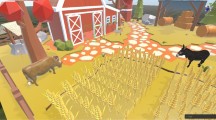Abstract
An object-oriented 3-D sound scene description scheme is proposed. The scheme establishes a way to compose and encode time-varying spatial sound scenes using audio and acoustical objects. This scheme can be used in applications where efficient coding of interactive 3-D sound scenes is needed (e.g. interactive virtual displays and videoconferencing). It can also be used in non-interactive application such as cinema and 3-D music. The scheme offers clear advantages over multi-channel 3-D sound formats regarding scalability and interactivity with the sound-scene because each object has its own set of parameters and can be modified by the end-user at the decoding stage. The object-oriented approach also allows the creation of macro-object descriptors that allow fast and efficient coding of 3-D sound scenes using references to macro-object libraries. The scheme has been implemented in a XML schema and can be used to define 3-D sound scenes in XML format in a standard way.
Access this chapter
Tax calculation will be finalised at checkout
Purchases are for personal use only
Preview
Unable to display preview. Download preview PDF.
Similar content being viewed by others
References
Begault, D.R., 3-D sound for virtual reality and multimedia, Academic Press, 1994.
World Wide Web Consortium: http://www.w3c.org
Bosi, M., Multichannel audio coding and its applications in DAB and DVB, International Conference on Communication Technology Proceedings, 2000. WCCICCT 2000, Vol. 2, 2001.
Sun Java home page: http://java.sun.com
World Wide Web Consortium: http://www.w3.org/DOM/
Vorländer, M., Simulation of the transient and steady-state sound propagation in rooms using a new combined ray-tracing/image-source algorithm, Journal of the Acoustical Society of America, Vol. 86(1), July 1989, pp 172–178.
Moorer, J.A., About This Reverberation Business, Computer Music Journal, Vol. 3(2), pp 13–28
Begault, D.R., Binaural Auralization and Perceptual Veridicality, Proceedings of the 93rd Audio Engineering Society, San Francisco, October 1992, Preprint 3421 (M-3)
Bauck, J. and Cooper, D.H, Developments in Transaural Stereo, IEEE workshop on Applications of Signal Processing to Audio and Acoustics, 1993, pp 114–117
Gerzon, M. A, Ambisonics in Multichannel Broadcasting and Video, Journal of the Audio Engineering Society, Vol. 33(11), November 1985, pp 859–871.
Ville Pulkki, Virtual Sound Source Positioning Using Vector Base Amplitude Panning, Journal of the Audio Engineering Society, Vol. 45(6), June 1997, pp 456–466
Web 3D Consortium: http://www.web3d.org
Overview of the MPEG-4 standard: http://mpeg.telecomitalialab.com/standards/mpeg-4/mpeg-4.htm
Whisper Laboratory Web page: http://www.whisper.elec.uow.edu.au/guillaume.htm
Author information
Authors and Affiliations
Editor information
Editors and Affiliations
Rights and permissions
Copyright information
© 2002 Springer-Verlag Berlin Heidelberg
About this paper
Cite this paper
Potard, G., Burnett, I. (2002). Using XML Schemas to Create and Encode Interactive 3-D Audio Scenes for Multimedia and Virtual Reality Applications. In: Plaice, J., Kropf, P.G., Schulthess, P., Slonim, J. (eds) Distributed Communities on the Web. DCW 2002. Lecture Notes in Computer Science, vol 2468. Springer, Berlin, Heidelberg. https://doi.org/10.1007/3-540-36261-4_18
Download citation
DOI: https://doi.org/10.1007/3-540-36261-4_18
Published:
Publisher Name: Springer, Berlin, Heidelberg
Print ISBN: 978-3-540-00301-4
Online ISBN: 978-3-540-36261-6
eBook Packages: Springer Book Archive




